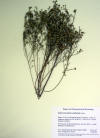|
Gutierrezia
californica
|
|
|
Gutierrezia microcephala |
Gutierrezia microcephala |
|
Gutierrezia
sarothrae |
Gutierrezia
sarothrae |
|
Gutierrezia
sarothrae |
Gutierrezia
sarothrae
|
|
Gutierrezia
sarothrae
|
Gutierrezia
sarothrae
|
|
Gutierrezia
sphaerocephalum
|
Gutierrezia
sp.
|
|
Trees and Shrubs of Kern County (Sep 2012) Gutierrezia
1. Flowers 2–4 per
head, the heads relatively small with 4–6 bracts,
1. Flowers >4 per
head, heads larger with more bracts, 2–5 mm thick,
2. Flower heads shaped
like a short wine glass 1.5–2× longer than
2. Flower heads more
narrow, ~2× longer than wide (2–3 mm diam.,
Gutierrezia californica (Brachyris californica DeCandolle 1836) Torrey & A. Gray 1842. [Includes G. bracteata Abrams 1907]. Matchweed. Subshrub with numerous slender erect angled branches to 1 m; leaves on lower part of stems in fascicles, spreading to deflexed or recurved, narrow and channeled along upper surface, to 5 cm long, 1mm wide, nearly uniform in width, gradually tapering to base and apex. Flowering May–Oct; flowers heads solitary at ends of branchlets, or additional heads also present just below, 5–7 mm long, 3–5 mm diam, with (4-) 6–13 (-16) disc flowers and (4-) 5 –10 (-13) ray flowers; cypselae with subcylindrical pericarpium 1–2.8 mm, hairy along areas between the nerves, and with terminal pale white elliptical scales nearly equal in length to the pericarpium, 1.5–2.2 mm. Herblands, woodlands and shrublands, mostly Inner Coast Ranges from near Clear Lake south to Peninsular Ranges, and to the Sierra Juárez in Baja California. California match week patches provisionally recognized in MCV2. Type from California without specific location. Kern Co.: “Common on the west side of the valley, in the Temblor Range south to Cuyama Valley, and on the lower slopes of the San Emigdio range; scarce in the east-side foothills” (Twisselmann),183–1,188 m (CCH). Gutierrezia californica Provisional Shrubland Alliance noted on Tejon Ranch Conservancy, Tri-Centennial (Magney 2010). Gutierrezia microcephala (Brachyris microcephala DeCandolle 1836) A. Gray 1849. Sticky snakeweed. Subshrub similar to G. sarothrae, or much-branched shrub, to 60 cm high and broad, somewhat rounded in outline, stems resinous, striate, leafy below; leaves long and narrow, >10× longer than wide, 2–5 cm × 0.5–2 mm. Flowering (Jun-) Jul–Oct (-Feb); flowering stems numerous; flower heads nearly in a flat top arrangement, 2–6 crowded at the ends of green leafless branchlets, subcylindric, 2–3.5 mm high, 1.5 mm diam., with 1 or 2 yellow ray and disc flowers, the ray(s) enfolded by an involucral bract(s); involucral bracts 4–6 (-8), yellowish white with pale greenish tips; cypselae with a subcylindric pericarpium 1–2 mm, and with terminal deciduous sword-shaped scales slightly shorter in length, 0.5–2 mm. Generally open rocky or gravel slopes and flats, especially limestone, creosote scrub to pinyon juniper woodland below 8,000 ft, southwestern North America. Type from Saltillo in the State of Coahuila, Mexico. Kern Co.: “Occasional in the shadscale scrub and creosote bush associations south to Fremont Valley” (Twisselmann), 662–1,189 m (CCH). Samples of the species from Texas and Arizona have shown antitumor activity in the NCI assays prior to 1980. Recollections by Spjut from Nevada in 1980 led to isolation of cytotoxic flavonols by Farnsworth Group at the University of Illinois at Chicago (Dong et al. 1987). Gutierrezia sarothrae (Solidago sarothrae Pursh 1814) Britton & Rusby 1887. Broom snakeweed. Subshrub much-branched above base, to 60 cm high and broad, often tightly compact and hemispherical, stems resinous, striate, leafy below but lower leaves often gone by flowering; leaves long and narrow, >10× longer than wide, 2–5 cm × 0.5–2 mm. Flowers Jul–Nov (-Jan); floral stems numerous with heads nearly in a flat top arrangement, (1-) 2–4 crowded at the ends of short-pedunculate green leafy branchlets, subcylindric, 3–5 (-6) mm high, 2.0 mm diam., with 2–7 yellow ray and 3–6 disc flowers, the ray(s) enfolded by an involucral bract(s); involucral bracts 8–14, yellowish white with greenish tips; cypselae with a subcylindric pericarpium 1–2 mm, and with terminal deciduous sword-shaped scales slightly shorter in length, 0.5–1.5 mm. Common along roadsides in desert regions below 8,000 ft, Midwest and western North America. Broom snake weed scrub provisionally recognized in MCV2. Type from plains of Missouri. Kern Co.: “Colonies in the Rosamond Hills and around Willow Springs and Cactus Butte, usually growing on gravelly slopes” (Twisselmann), 375–1,402 m (CCH). Gutierrezia sarothrae Provisional Shrubland Alliance noted on Tejon Ranch Conservancy, Tri-Centennial (Magney 2010). A protein active in SA was reportedly isolated from a sample of this species (Hartwell 1976).
References on Pharmacological Activity in Gutierrezia Dong X. P., C. T. Che and N. R. Farnsworth. Cytotoxic flavonols from Gutierrezia microcephala. 1987. J. Nat. Prod. 50(2): 337–338. |
|

















